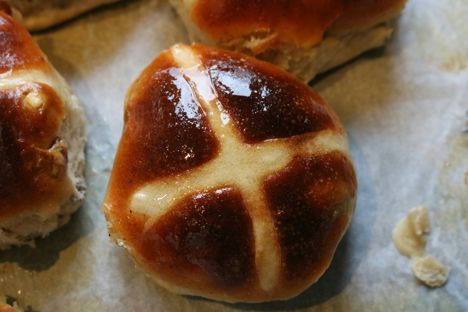
The History of Hot Cross Buns
Hot cross buns have a long and, sometimes, contentious history, having been eaten in the UK for centuries. We delve into the history of this much-loved Easter treat in collaboration with Doves Farm.
The History of Hot Cross Buns
Hot cross buns have a long and, sometimes, contentious history, having been eaten in the UK for centuries. We delve into the history of this much-loved Easter treat in collaboration with Doves Farm.
Although traditionally eaten on Good Friday alone, hot cross buns are now available and eaten in the UK throughout (and even outside of) the whole Easter period. And who can blame us? They’re delicious. The best ones are lightly sweetened, fragrant with spices and studded with plump little fruits. Eating some sort of enriched bread or cake at Easter is hardly a tradition unique to the UK though – Italy has colomba, Greece has flaouna, Portugal has folar. It makes sense to have some way of celebrating six weeks of fasting, and a rich, fruity bread is a delicious choice. And there is now a proliferation of different hot cross bun choices – hot cross bun blondies, gluten-free buns with buckwheat flour, vegan, chocolate and even savoury variations such as Gabriel Waterhouse’s miniature lamb-filled buns.
The tradition of eating sweet buns in spring is often claimed to entirely predate Christian times, which will make sense to anyone who has spent time in the UK in February. Winter in Britain is hard and miserable enough in the twenty-first century when we have central heating and Netflix, let alone thousands of years ago. Many books on the history of Easter or British baking will confidently explain that the first springtime spiced buns were offered to the Anglo-Saxon goddess Eostre as a tribute, and explain that her name is also the etymology of Easter. The problem with this very believable story is that the only historical source which references Eostre being Easter’s namesake is the writing of a single eighth century monk. Some sceptical historians think the whole story could be too convenient to be true, and it seems more likely that the buns are a much more modern invention.
But while hot cross buns aren’t necessarily quite as ancient as the Romans, they’ve certainly been eaten in the UK for centuries. The song ‘One a penny, two a penny’ alone dates back to the mid 1700s. And while many Christian countries, as mentioned above, have enriched buns, one of the unusual features of hot cross buns is their eponymous cross. Modern hot cross buns have crosses made from everything you can think of – chocolate, icing, pastry or simply a flour and water paste. But originally the buns had quite a different design. They were scored with a knife to give the distinctive cross, so that they had a split top more like a soda bread.
It is this split-top version that is served at St. Albans cathedral, who also claim to have played a role in the invention of the hot cross bun. The story goes that in the fourteenth century a monk made buns closely resembling hot cross buns to distribute to the poor. However, the classicist Peter Gainsford cast some doubt on this story, after he tracked down the original version of the story in a 1850 advert for a London bakery. The bakery claims to serve buns made from the monk’s ancient, secret recipe. However, the fourteenth century Book of St. Albans – allegedly the source of the bun recipe – contained no such thing. So the search for the original hot cross bun continues.
As far back as we can trace hot cross buns however, they have been massively popular. Stories abound about bakeries being harangued by enormous crowds when their buns went on sale. Hawkers sang their now-famous song throughout the streets, and sold buns from dawn till dusk. The Chelsea Bun House was a particularly popular place to buy the buns, and is said to have been mobbed by poorly-behaved bun lovers in 1792 to such a degree that the owners somewhat sulkily refused to sell hot cross buns the following year.
In the Elizabethan Era the monarchy attempted in vain to keep a lid on spiced bun mania. In Elizabeth David’s English Bread and Yeast Cookery she explains that in 1592 the London Clerk of the Markets banned the selling of spiced buns except on Good Friday, Christmas and funerals. However, the ban didn’t last long and by the early seventeeth century buns were available throughout the Easter period once again.
But while Easter hot cross buns have never gone out of style, they have adapted to the times. Using Doves Farm’s organic flours is a great way to give hot cross bun recipes a modern twist, like our caramelised apple and cinnamon hot cross buns with a ginger syrup glaze, which uses white spelt flour from Doves Farm. More classic buns can also be given a healthier twist by substituting some plain flour for nutty Doves Farm oat flour, or you can boost the nutrition of a hot cross bun brownie with some Doves Farm wholemeal rye flour, which pairs beautifully with cocoa. We also have a recipe for a gluten-free hot cross bun, which uses a combination of gluten-free flour and buckwheat flour.
Wherever they came from – and whatever they evolve into in the future – it seems likely that hot cross buns will stick around. They’ve stood the test of time, and we hope you’ll find the perfect hot cross bun for you.


